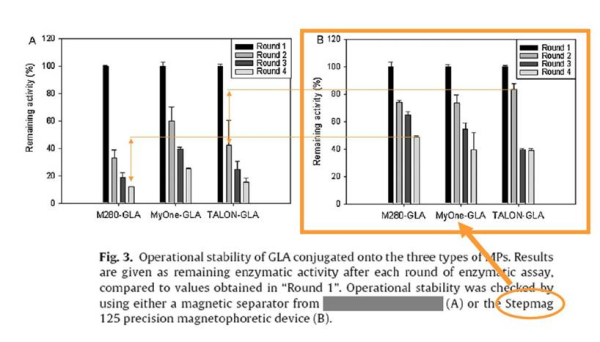Researchers of the CIBER-BBN, the Institut de Biotecnologia i de Biomedicina and the Department of Genetics and Microbiology of the Universitat Autònoma de Barcelona and Sepmag have recently published the paper “Enzymatic characterization of highly stable human alpha-galactosidase A displayed on magnetic particles” on the Biochemical Engineering Journal.

One of the key points for the operational stability of coated magnetic particles is their recovery. If particles are lost, it is difficult to analyze the stability of the enzymes, as most of the activity reduction is due to the material losses. The problem is especially critical on enzymatic catalysis, as the concentration is very low, making impossible to visually monitor the magnetic separation process.
The authors have used a classical laboratory magnetic separation rack and a Stepmag 125 precision magnetophoresis device. Applyng the same separation time, the authors obtained the results show at the figure:
“On the other hand, operational stability of all GLA-coated MPs using the magnetic separator from XXXXXXX permitted reusing them up to at least 4 cycles, although the enzymatic activity decreased progressively (Fig. 3A). After 4 rounds, ~25% of remaining activity was observed for MyOne MPs, while only ~15% of activity was detected for M-280 and TALON MPs. The operational stability when using a STEPMAG 125 as a magnetic capture device was clearly improved, as well as the reproducibility of the process (Fig. 3B)…”
Due the better magnetic particles recovery using SEPMAG systems, further work is in progress to optimize the protocols. As the authors write
"…Therefore, capture time and bead concentrations should be studied and optimized when using magnetic carriers. Moreover, and according to our results, it is clear the impact of the magnetic separator used on the MPs capture efficiency. In contrast to devices rendering non-homogeneous magnetic fields, precision magnetophoretic systems, like the STEPMAG 125 device, provide a magnetic field high enough to saturate the particles (then every bead acts as small magnet) and a uniform magnetic field gradient (all the particles experience the same magnetic force). As shown, optimizing magnetophoretic conditions can minimize MPs looses during washing steps, resulting in a better operational stability."
REF: J.L. Corchero et al. Biochemical Engineering Journal 67 (2012) 20– 27


